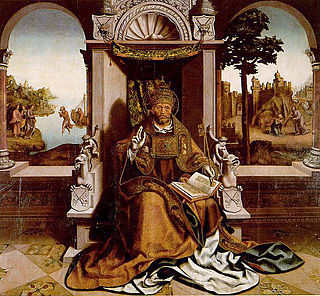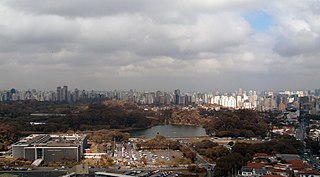
Funchal is the largest city, the municipal seat and the capital of Portugal's Autonomous Region of Madeira, bordered by the Atlantic Ocean. The city has a population of 111,892, making it the sixth largest city in Portugal, and has been the capital of Madeira for more than five centuries. Because of its high cultural and historical value, Funchal is one of Portugal's main tourist attractions. It is also popular as a destination for New Year's Eve, and it is the leading Portuguese port on cruise liner dockings.

The Calouste Gulbenkian Museum, also known simply as the Gulbenkian Museum, is a major encyclopedic art museum in Lisbon, Portugal, in the civil parish of Avenidas Novas. As part of the Calouste Gulbenkian Foundation, one of the wealthiest foundations in the world, the Gulbenkian Museum houses one of the largest private collections of art in the world. It encompasses the art of the world from antiquity forward, and was the private collection of a single man, oil magnate Calouste Gulbenkian.

Jan Provoost, or Jean Provost, or Jan Provost was a Belgian painter born in Mons.

Dieric Bouts was an Early Netherlandish painter.

The Museu Nacional d'Art de Catalunya, abbreviated as MNAC, is the national museum of Catalan visual art located in Barcelona, Catalonia, Spain. Situated on Montjuïc hill at the end of Avinguda de la Reina Maria Cristina, near Pl Espanya, the museum is especially notable for its outstanding collection of romanesque church paintings, and for Catalan art and design from the late 19th and early 20th centuries, including modernisme and noucentisme. The museum is housed in the Palau Nacional, a huge, Italian-style building dating to 1929. The Palau Nacional, which has housed the Museu d'Art de Catalunya since 1934, was declared a national museum in 1990 under the Museums Law passed by the Catalan Government. That same year, a thorough renovation process was launched to refurbish the site, based on plans drawn up by the architects Gae Aulenti and Enric Steegmann, who were later joined in the undertaking by Josep Benedito. The Oval Hall was reopened in 1992 on the occasion of the Olympic Games, and the various collections were installed and opened over the period from 1995 to 2004. The Museu Nacional d'Art de Catalunya was officially inaugurated on 16 December 2004. It is one of the largest museums in Spain.

The Museu Nacional de Arte Antiga, also known in English as the National Museum of Ancient Art, is the Portuguese national art museum, located in Lisbon. The MNAA has one of the largest art collections in the world, with over 40,000 items spanning a vast collection of painting, sculpture, goldware, furniture, textiles, ceramics, and prints. It is one of the most visited museums in Portugal.

Vasco Fernandes, better known as Grão Vasco, was one of the main Portuguese Renaissance painters.

The Museu Nacional de Belas Artes is a national art museum located in the city of Rio de Janeiro, Brazil. The museum, officially established in 1937 by the initiative of education minister Gustavo Capanema, was inaugurated in 1938 by President Getúlio Vargas. The museum collection, on the other hand, takes its rise in the transfer of the Portuguese Court to Brazil in the early 19th century, when King John VI brought along with him part of the Portuguese Royal Collection. This art collection stayed in Brazil after the King's return to Europe and became the core collection of the National School of Fine Arts. When the museum was created in 1937, it became the heir not only the National School collection, but also of its headquarters, a 1908 eclectic style building projected by Spanish architect Adolfo Morales de los Ríos.

The Diocese of Funchal was created originally on 12 June1514, by bull Pro excellenti præeminentia of Pope Leo X, following the elevation of Funchal from a village to the status of city, by King Manuel I of Portugal. The new diocese was a suffragan of the Archdiocese of Lisbon.
Albuquerque Mendes is a Portuguese artist. He works in the fields of painting, performance art and installation.
Sofia Areal is a Portuguese abstract painter, who has a strong chromatic focus, whose works adhere mostly to organic non-geometrical forms. Besides painting and drawing, Areal's work also focuses on collage, textile design, and scenography.

Museu Afro Brasil is a history, artistic and ethnographic museum dedicated to the research, preservation, and exhibition of objects and works related to the cultural sphere of blacks in Brazil. It is a public institution held by the Secretariat for Culture of the São Paulo State and managed by the Museu Afro Brasil Association. The museum is located in Ibirapuera Park, a major urban park in São Paulo. The Manoel da Nóbrega Pavilion, designed by Oscar Niemeyer in 1959, houses the Museum. It holds around 6 thousands items and pieces, amongst them are paintings, sculptures, photos, documents, archives etc. created between the 15th Century and the present day. The aggregation of pieces includes many works of the African and Afro-Brazilian cultural spheres, ranging from subjects and topics such as religion, labor, and art to the African Diaspora and slavery, whilst registering and affirming the historical trajectory and the African influences in the construction of the Brazilian society. The Museum also offers a diverse range of cultural and didactic activities, temporary expositions, and contains a theater and a specialized library.

Museum of Art of the Parliament of São Paulo(Museu de Arte do Parlamento de São Paulo), is a contemporary art museum housed in the Palácio 9 de Julho, the Legislative Assembly of São Paulo house. The Palace is located in south of the city, opposite to the Ibirapuera Park.

The Museum of Sacred Art of São Paulo a museum dedicated to the collection and display of sacred art of Brazil. It is located in the Luz neighborhood of São Paulo in the left wing of the Luz Monastery, a religious institution founded in 1774 by Frei Galvão. The monastery is the only colonial building of the eighteenth century in São Paulo to preserve its original building elements, materials and structure. The monastery was listed as an architectural monument of national importance in 1943 by the National Institute of Historic and Artistic Heritage (IPHAN) and subsequently by the State of São Paulo Council for the Defense of the Historical, Archaeological, Artistic and Touristic Heritage (CONDEPHAAT).

The Fort of São Tiago is located in the historical centre of Funchal, Madeira.

The Museu CR7 is a museum that is dedicated to Cristiano Ronaldo's trophies. It is located in Funchal, Madeira.
Diogo de Contreiras was a Portuguese Mannerist painter, active between 1521 and 1562. He has been identified as the painter referred to as the Master of Saint Quentin. The identification of de Contreiras as the Master of Saint Quentin was determined by Martin Soria (1957) and later reinforced by Vítor Serrão.

The Museum of Modern Art of Bahia is a modern art museum located in Salvador, Bahia, Brazil. It is located within Solar do Unhão, a historical site dating to the 16th century, on the margin of the Bay of All Saints. The museum was founded in 1960 under the architect Lina Bo Bardi (1914-1992) and initially located in the foyer of the Castro Alves Theater; it moved to its present location in 1963. MAM-BA is one of twelve state museums linked to the Institute of Artistic and Cultural Heritage (IPAC), an authority of the Department of Culture of the State of Bahia.
















